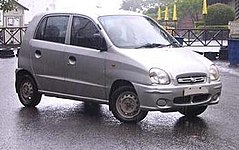Hyundai Santro
| Hyundai Santro | |
|---|---|
 | |
| Overview | |
| Manufacturer | Hyundai |
| Also called | Hyundai Atos |
| Production | 1998–2015 2018–2022 |
| Body and chassis | |
| Class | City car (A) |
| Body style | 5-door hatchback |
| Layout | Front-engine, front-wheel-drive |
The Hyundai Santro is a city car produced by the South Korean manufacturer Hyundai between 1998 and 2014. The nameplate was revived in 2018 to replace the Eon, and was produced until 2022. The "Santro" nameplate was applied during its first generation to the Atos Prime model, while the second generation is a standalone model.
Hyundai derived the name Santro for the Indian market from Saint-Tropez, a French city famous for fashion, because the company wanted to project it as a ‘fashionable’ car.[1][2]
First generation (MX; 1998)
[edit]- 2001 Hyundai Santro (MX; 1998–2003)
- Hyundai Santro Xing (2003–2015)
- A blue 2004 Hyundai Santro in Pakistan
- Hyundai Santro 2004 interior
The first generation Santro was introduced in 1998 and went on sale in early 1999. It was also sold in Europe as the Atos Prime and in South Korea and Indonesia as the Kia Visto. It was also known as the Santro Zip in India from 1998 to 2006.
Before the Kia Visto was replaced by the Kia Picanto in 2004, the facelifted Santro was launched in 2003. It was known as the Santro Xing in India from 2003 to 2014.
Second generation (AH2; 2018)
[edit]| Second generation (AH2) | |
|---|---|
 Hyundai Atos 1.1 Plus (Chile) | |
| Overview | |
| Also called | Hyundai Atos |
| Production | 2018–2022 |
| Assembly | India: Chennai (Hyundai India) |
| Body and chassis | |
| Platform | Hyundai-Kia K1 |
| Related | Hyundai Grand i10 (AI3) |
| Powertrain | |
| Engine | |
| Transmission |
|
| Dimensions | |
| Wheelbase | 2,400 mm (94.5 in) |
| Length | 3,610 mm (142.1 in) |
| Width | 1,645 mm (64.8 in) |
| Height | 1,560 mm (61.4 in) |
| Chronology | |
| Predecessor | Hyundai Eon |
The second generation Santro was launched on 23 October 2018 in India. This marked the return of the Santro nameplate in India after four years since the last generation was discontinued and nearly twenty-five years since the start of production. It was positioned below the Hyundai i10.[3]
The model was powered by a 1.1-litre Epsilon G4HG petrol which produces 69 hp (51 kW; 70 PS) at 5,500 rpm and 10.1 kg⋅m (73 lb⋅ft; 99 N⋅m) torque at 4,500 rpm. A bi-fuel version of the engine that uses both petrol and CNG is also available. Transmission options consisted of a 5-speed manual and a 5-speed automated manual.[4]
It was one of the Top 3 Urban World Cars of 2019.[5]
The second generation Santro was discontinued in 2022.
- 2020 Hyundai Atos (Brunei)
- Interior
Safety
[edit]The Indian version of the Santro with driver airbag scored 2 stars for adult and child occupant protection in the Global NCAP's frontal offset crash tests under its Safer Cars for India project in 2019 (similar to Latin NCAP 2013).[6]
| Global NCAP scores (2019)[7] | |
| Adult occupant stars | |
| Adult occupant | 6.74/17.00 |
| Child occupant stars | |
| Child occupant | 15.00/49.00 |
References
[edit]- ^ "New Hyundai Santro launch on October 23; six reasons why company feels it will be winner again". The Financial Express. 20 October 2018. Retrieved 29 December 2019.
- ^ "What does this French Riviera resort town have to do with the Indian automotive industry?". YouTube. 8 November 2021.
- ^ Siddharth Vinayak Patankar (2018-10-29). "2018 Hyundai Santro Review". NDTV. Retrieved 2018-11-06.
- ^ Siddharth Vinayak Patankar (2018-10-09). "2018 Hyundai Santro First Drive". NDTV. Retrieved 2018-11-13.
- ^ Kaushik, Chhavi (2019-03-07). "2019 World Urban Car Award: Hyundai Santro Among Top 3 Finalist". India Car News. Retrieved 2020-12-06.
- ^ "Hyundai Santro receives two-star Global NCAP rating". Autocar India. Retrieved 2019-12-15.
- ^ "Results". GLOBAL NCAP.
External links
[edit]- Official website (Hyundai India)[dead link]


 French
French Deutsch
Deutsch




